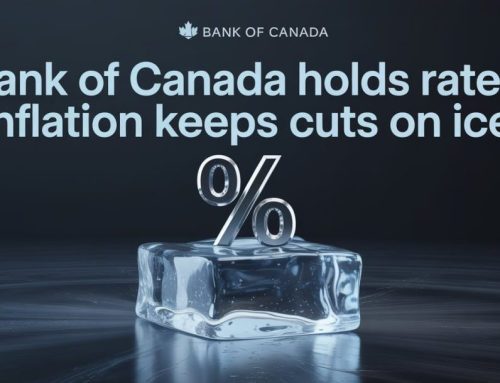Whenever there is talk about the Bank of Canada increasing rates, many start to wonder if they should convert their variable rate mortgage into a fixed. Some will automatically fear the worst which can lead to panic resulting in them making a move that they might later regret. “My neighbour told me rates are going to 20% and that I better lock in now!”
When choosing a variable rate mortgage, it’s important to understand that rate will move in either direction over the course of the five-year term. There will be upward swings and there will be downward swings. We’re currently in an upward swing, which is expected to continue into 2023.
Does this mean that you should get ahead of the game on lock into a fixed rate now?
Converting To A Fixed Rate
When converting to a fixed, you are immediately accepting a much higher rate and higher payment along with it. Locking in is another way of saying that you would prefer to pay a higher rate right away, rather than waiting to see what is going to happen.
If you were to make this move now, the lowest fixed rates you can expect would be 3.84% to 4.14%, depending on which lender you’re with. If you are currently in a variable rate mortgage at prime -1.00% (currently 2.20%), then converting to 3.84% would represent an immediate rate increase of 1.64%.
On a $500,000 mortgage, this would mean a monthly payment increase of roughly $400 per month (depending on amortization) that would be applied 100% towards interest.
In this situation, it would take seven more 0.25% by the Bank of Canada for your variable rate to move up above the 5 year fixed rate you would be converting to. It’s possible that this could happen by the end of 2022 or sometime in 2023.
Possible.
That doesn’t mean that it will happen.
It also doesn’t mean that everyone should be locking into a fixed rate.
With Canadian household debt at an all-time record high, the impact of each rate increase is intensified. This should mean that fewer rate increases will be required. It’s quite possible that the Bank of Canada won’t need to be as aggressive as what some are anticipating.
Even if your current variable rate does move up over today’s lowest 5 year fixed rate, it doesn’t mean that you should have taken the fixed. It just means that you’re giving back some of your savings. In fact, it can go quite a bit higher and you can still come out ahead with a variable rate.
Rates will increase, but there will also be decreases that will follow which I’ll discuss later in this blog.
An Alternative To Converting To A Fixed Rate
If you’re comfortable making a higher payment, then I would recommend using your prepayment privileges to match the higher payment you would expect to pay if you converted to the fixed rate. This way, 100% of the additional payment will be applied to the principal, rather than to interest.
If you’re going to make a higher payment, then why not have it serve you, rather than serving the lender?
For every $100 you increase your payment by, that is $100 less that you’ll need to pay interest on… starting with your very next payment and every other payment to follow.
More Increases To Come With Rate Cuts To Follow
The Bank of Canada has already increased their key policy rate by 0.75% since March 2nd of this year, which has brought the prime rate up to 3.20%. While this is a large increase in a relatively short period of time, it would have to increase by another 0.75% before it equals the pre-pandemic rate of 3.95%.
More increases are expected, and the prime rate will likely exceed this before the end of the summer. There is speculation that it will increase by another 1.00% – 2.00% before the end of 2022.
But how likely is this to happen?
The Bank of Canada has a major inflation problem on their hands. They should have increased their rate back on January 26th to prevent it from getting out of control. But they didn’t anticipate the war in Ukraine, which is further weakening the supply chain and therefore throwing fuel on the inflation problem.
This is why they said they are ‘prepared to act forcefully’, which is being interpreted as multiple 0.50% rate increases. When the Bank of Canada makes a move, it’s usually by 0.25% at a time. It’s rare for them to move by a larger margin, which they only do in extreme situations, which they are in now. The 0.50% increase we saw on April 13th was the first double increase in 22 years.
It’s possible that the BOC could increase their rate by another 0.50% on their next scheduled rate announcement date of June 1st, with the standard 0.25% increases to follow.
They are prepared to do whatever it takes to combat inflation, but that will come at the expense of the economy.
However, the Bank needs to put inflation in front of the economy. These moves are required, otherwise, everyone’s living expenses are going to get out of control. Look at what is happening to the price of gas, groceries, etc. It will get much, much worse if they don’t act. A large part of the current upswing in inflation is due to supply issues which have worsened due to the war in Ukraine.
Increasing rates will not change the supply issue, but they can help to bring demand down to match the current supply.
They need to act more radically in the beginning, but once inflation is under control, their focus will then shift to protecting the economy.
At that point, rate cuts can be expected. This should happen within the next two years.
Conclusion
By locking into a fixed mortgage rate, you’re locking in when fixed rates are the highest they have been in more than 10 years. I personally think that the bond market is overreacting a bit, which is forcing fixed rates higher than they need to be. They will eventually come back down.
We would need a crystal ball to know what will happen over the next 5 years. It’s anyone’s guess. It looks like a recession is coming, which the Bank of Canada will need to deal with by lowering its rate. This is what can be expected as I’ve been saying since late 2021, however, anything can happen.
What’s right for one person might not be right for the next. If you are truly worried about the future of mortgage rates, then locking into a fixed rate might be worth considering. I fully believe that variable rates will come out ahead over fixed over the next 5 years. But if you’re going to be fraught with worry to the point where you’re not able to sleep at night, then locking in can give you peace of mind knowing that you’re protected. But you may later regret this decision should the rates start to come back down.
Everyone is a bit different, and you have to do what you think is best for you and your family.








Leave A Comment